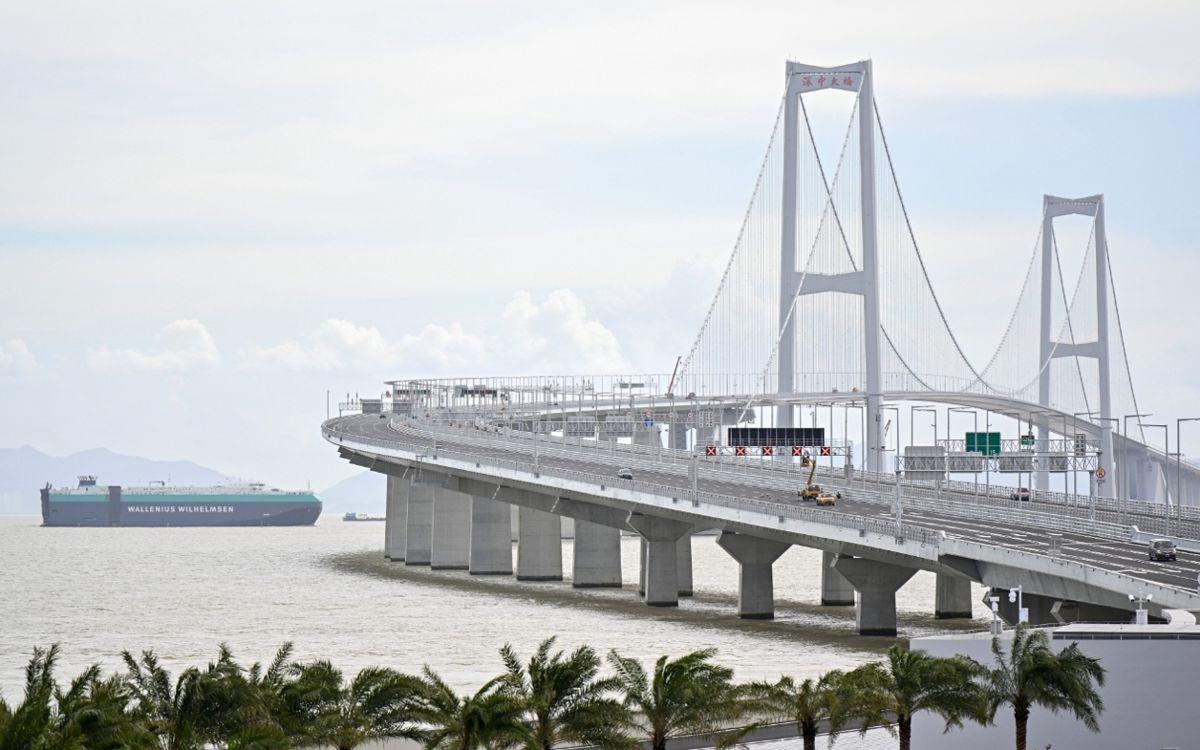R.E.News International-The Shenzhen-Zhongshan Link – China’s latest Megaproject
 11/07/24-FR-English-NL-footer
11/07/24-FR-English-NL-footer
La liaison Shenzhen-Zhongshan – le dernier mégaprojet chinois
 A view of the Shenzhen-Zhongshan Link, a mega cross-sea passage in the Great Bay Area, June 27, 2024. Image courtesy
A view of the Shenzhen-Zhongshan Link, a mega cross-sea passage in the Great Bay Area, June 27, 2024. Image courtesy
La liaison Shenzhen-Zhongshan, un méga passage maritime dans le sud de la Chine composé d'un tunnel sous-marin, de deux ponts et de deux îles artificielles, a été ouverte à la circulation dimanche.
Sept ans plus tard, les concepteurs et constructeurs chinois ont surmonté certains des défis techniques les plus urgents au monde, transformant le passage du projet à la réalité et établissant 10 records du monde.
Mercredi, China News Network en a interviewé quelques-uns et a découvert les histoires derrière l'un des projets de cluster trans-marins les plus ambitieux au monde.
Pas de place à l'erreur
Ce passage de 24 kilomètres, reliant Shenzhen à l'est de l'estuaire de la rivière des Perles à Zhongshan à l'ouest, a considérablement réduit le temps de trajet entre les deux villes, passant d'environ deux heures à moins de 30 minutes.
Il est équipé de nombreux dispositifs pour assurer son fonctionnement sûr et stable.
Le personnel de construction doit construire un pont suspendu avec une hauteur de tour de 270 mètres et une travée principale de 1 666 mètres à environ 15 kilomètres au large de la côte. Ils doivent également atteindre une précision millimétrique en amarrant 23 tubes immergés, pesant chacun environ 80 000 tonnes métriques, sur le fond marin à près de 40 mètres de profondeur dans la mer de Lingdingyang. De plus, dans moins de six mois, ils doivent créer une île dans la mer d’une superficie équivalente à 19 terrains de football aux normes internationales.
Malgré d'énormes défis lors de la construction, ces projets ont tous été achevés dans les délais prévus.
Chen Weibin, directeur général du centre technologique et chef de projet du contrat 9 de liaison Shenzhen-Zhongshan pour la préfabrication du tunnel immergé de CCCC Fourth Harbor Engineering Co., Ltd., a présenté que : « le processus de construction du passage qui a adopté une coque en acier immergée les structures tubulaires sont irréversibles et il n’y avait aucune marge d’erreur ».
Sans aucune leçon à tirer, l’équipe du projet a adopté la technologie d’impression 3D pour développer un système de coulée intelligent personnalisé, économisant ainsi 2 500 heures de temps machine.
Technologies clés développées de manière indépendante
Dans le domaine de la construction, des avancées ont également été réalisées dans la domestication des technologies clés.
Suo Xuhong, directeur du centre de gestion des mesures du département de gestion de projet de liaison Shenzhen-Zhongshan de CCCC – First Harbour Engineering Company, a présenté qu'au cours des sept dernières années, son équipe a généré plus de 170 brevets, réalisant huit innovations et réalisations technologiques majeures, notamment des progrès rapides formation d'îlots et joints finaux de type poussée sous-marine.
Par exemple, il a expliqué que : « face à des conditions géologiques et hydrologiques complexes, nous avons développé de manière indépendante « l’imprimante 3D sous-marine » – un navire de nivellement de gravier. Nous avons réalisé une localisation complète du matériel et des logiciels, avec une précision et une efficacité de nivellement répondant aux exigences de diverses spécifications de construction de tunnels à tubes immergés. De plus, nous avons intégré le système BeiDou dans la construction de tubes immergés pour la première fois au monde et développé un joint final de type poussoir sous-marin préfabriqué intégral.
L’environnement écologique marin dépasse les coûts
La construction de la liaison Shenzhen-Zhongshan attache également une grande importance à la protection de l'environnement écologique marin. Ma Dingqiang, directeur général adjoint de la branche de dragage de la CCCC-Guangzhou DREDGING CO., LTD, et chef de projet des travaux de dragage pour le projet de liaison Shenzhen-Zhongshan (section 09), a déclaré qu'au cours du processus d'excavation des tranchées, un grand Une grande quantité de roches décomposées s'est répandue sur le fond marin.
Ma a expliqué que selon les méthodes de dragage traditionnelles, l'approche la plus efficace, la plus économique et la plus conventionnelle serait le dynamitage. Cependant, le chantier de construction est situé dans l'estuaire de la rivière des Perles, qui se trouve sur la route de migration et constitue un habitat important pour le dauphin blanc de Chine.
Après évaluation, une technique précise de brise-roche mécanique pour les eaux profondes et les tranchées profondes a été développée.
« Cette avancée a nécessité un coût financier d'environ 30 millions de yuans (4,13 millions de dollars) et un investissement en temps de plus d'un an. Cependant, l’impact sur l’habitat du dauphin blanc de Chine a été minimisé », a déclaré Ma.
Environ 24 heures après l'ouverture de la liaison à la circulation, le volume du méga passage maritime avait atteint 125 000 véhicules, selon le Guangdong Transportation Group.
NJC.© Info China News Network
----------------------------------------------------------------------------------------------------------------
 11/07/24-English
11/07/24-English
The Shenzhen-Zhongshan Link – China’s latest Megaproject
 A view of the Shenzhen-Zhongshan Link, a mega cross-sea passage in the Great Bay Area, June 27, 2024. Image courtesy
A view of the Shenzhen-Zhongshan Link, a mega cross-sea passage in the Great Bay Area, June 27, 2024. Image courtesy
The Shenzhen-Zhongshan Link, a mega cross-sea passage in south China that consists of one underwater tunnel, two bridges, and two artificial islands, opened to traffic on Sunday.
Seven years on, Chinese designers and constructors have overcome some of the world’s most pressing technical challenges, transforming the passage from a blueprint to a reality and setting 10 world records.
On Wednesday, China News Network interviewed some and discovered the stories behind the one of the most challenging cross-sea cluster projects in the world.
No room for error
This 24-kilometer passage, connecting Shenzhen in the east of the Pearl River estuary with Zhongshan in the west, has significantly slashed travel time between the two cities from about two hours to under 30 minutes.
It is equipped with numerous devices to ensure its safe and stable operation.
The construction personnel need to build a suspension bridge with a tower height of 270 meters and a main span of 1,666 meters approximately 15 kilometres off the coast. They also need to achieve millimetre-level precision in docking 23 immersed tubes, each weighing about 80,000 metric tons, on the seabed nearly 40 meters deep in the Lingdingyang sea. Additionally, within less than six months, they must create an island in the sea with an area equivalent to 19 international standard football fields.
Despite enormous challenges during the construction, these projects were all completed within the scheduled time.
Chen Weibin, General Manager of Technology Center and Project Manager of Shenzhen-Zhongshan Link Contract 9 for Precasting of Immersed Tunnel of CCCC Fourth Harbor Engineering Co., Ltd., introduced that: “the construction process of the passage that adopted steel-shell immersed tube structures is irreversible and there was no room for error”.
Without any lesson to learn from, the project team adopted 3D printing technology to develop a customized intelligent pouring system, saving 2,500 hours of machinery time.
Independently-developed key technologies
In the construction, breakthroughs in domesticating key technologies have also been achieved.
Suo Xuhong, Director of the Measurement Management Center of CCCC – First Harbor Engineering Company’s Shenzhen-Zhongshan Link Project Management Department, introduced that over the past seven years, his team has generated over 170 patents, achieving eight major technological innovations and accomplishments, including rapid island formation and underwater push-type final joints.
For example, he elaborated that: “facing complex geological and hydrological conditions, we independently developed the ‘underwater 3D printer’ — a gravel levelling ship. We have achieved full localization of both hardware and software, with leveling precision and efficiency meeting the requirements for various specifications of immersed tube tunnel bed construction. Additionally, we integrated the BeiDou system into immersed tube construction for the first time in the world, and developed an integral prefabricated underwater push-type final joint.”
Marine ecological environment outweighs cost
The construction of the Shenzhen-Zhongshan Link also attaches great importance to protecting the marine ecological environment. Ma Dingqiang, deputy general manager of the Dredging Branch Company under CCCC-Guangzhou DREDGING CO., LTD, and project manager of the dredging works for the Shenzhen-Zhongshan Link Project (section 09), said that during the trench excavation process, a large amount of decomposed rocks were found to have distributed on the seabed.
Ma explained that according to traditional dredging methods, the most efficient, economical, and conventional approach would be blasting. However, the construction site is located in the Pearl River Estuary, which is on the migration route and an important habitat for the Chinese white dolphin.
After evaluation, a precise mechanical rock-breaking technique for deep water and deep trenches was developed.
“This advancement came at a financial cost of about 30 million yuan ($4.13 million) and a time investment of more than one year. However, the impact on the habitat of the Chinese white dolphin was minimized,” Ma stated.
About 24 hours after the link opened to traffic, the volume on the mega cross-sea passage had reached 125,000 vehicles, according to the Guangdong Transportation Group.
NJC.© Info China News Network
----------------------------------------------------------------------------------------------------------------------
 11/07/24-NL
11/07/24-NL
De Shenzhen-Zhongshan Link – het nieuwste megaproject van China
 A view of the Shenzhen-Zhongshan Link, a mega cross-sea passage in the Great Bay Area, June 27, 2024. Image courtesy
A view of the Shenzhen-Zhongshan Link, a mega cross-sea passage in the Great Bay Area, June 27, 2024. Image courtesy
De Shenzhen-Zhongshan Link, een mega-zeepassage in Zuid-China die bestaat uit één onderwatertunnel, twee bruggen en twee kunstmatige eilanden, is zondag opengesteld voor verkeer.
Zeven jaar later hebben Chinese ontwerpers en constructeurs enkele van de meest urgente technische uitdagingen ter wereld overwonnen, waardoor de overgang van een blauwdruk naar een realiteit is getransformeerd en 10 wereldrecords zijn gevestigd.
Woensdag interviewde China News Network sommigen en ontdekte de verhalen achter een van de meest uitdagende cross-sea clusterprojecten ter wereld.
Geen ruimte voor fouten
Deze 24 kilometer lange passage, die Shenzhen in het oosten van de monding van de Parelrivier verbindt met Zhongshan in het westen, heeft de reistijd tussen de twee steden aanzienlijk teruggebracht van ongeveer twee uur tot minder dan 30 minuten.
Het is uitgerust met talrijke apparaten om een veilige en stabiele werking te garanderen.
Het bouwpersoneel moet ongeveer 15 kilometer uit de kust een hangbrug bouwen met een torenhoogte van 270 meter en een hoofdoverspanning van 1.666 meter. Ze moeten ook millimeterprecisie bereiken bij het aanmeren van 23 afgezonken buizen, elk met een gewicht van ongeveer 80.000 ton, op de zeebodem, bijna 40 meter diep in de Lingdingyang-zee. Bovendien moeten ze binnen minder dan zes maanden een eiland in de zee creëren met een oppervlakte gelijk aan 19 internationale standaardvoetbalvelden.
Ondanks enorme uitdagingen tijdens de bouw zijn deze projecten allemaal binnen de geplande tijd afgerond.
Chen Weibin, algemeen directeur van het Technology Center en projectmanager van Shenzhen-Zhongshan Link Contract 9 voor het prefabriceren van de ondergedompelde tunnel van CCCC Fourth Harbor Engineering Co., Ltd., introduceerde het volgende: “Het constructieproces van de doorgang waarbij gebruik werd gemaakt van ondergedompelde stalen omhulsels buisconstructies zijn onomkeerbaar en er was geen ruimte voor fouten”.
Zonder enige les om van te leren, adopteerde het projectteam 3D-printtechnologie om een op maat gemaakt intelligent gietsysteem te ontwikkelen, waardoor 2.500 uur aan machinetijd werd bespaard.
Onafhankelijk ontwikkelde sleuteltechnologieën
In de bouw zijn ook doorbraken bereikt in het domesticeren van sleuteltechnologieën.
Suo Xuhong, directeur van het Measurement Management Center van CCCC – de Shenzhen-Zhongshan Link Project Management Department van First Harbor Engineering Company, introduceerde dat zijn team de afgelopen zeven jaar meer dan 170 patenten heeft gegenereerd, waarmee acht grote technologische innovaties en prestaties zijn bereikt, waaronder snelle eilandvorming en onderwater-duwverbindingen.
Hij legde bijvoorbeeld uit dat: “we, geconfronteerd met complexe geologische en hydrologische omstandigheden, onafhankelijk de ‘onderwater 3D-printer’ ontwikkelden – een grindnivelleringsschip. We hebben volledige lokalisatie van zowel hardware als software gerealiseerd, waarbij de waterpasnauwkeurigheid en -efficiëntie voldoen aan de vereisten voor verschillende specificaties van de constructie van tunnelbedden met afgezonken buizen. Daarnaast hebben we voor het eerst ter wereld het BeiDou-systeem geïntegreerd in de constructie van afgezonken buizen, en hebben we een integrale geprefabriceerde onderwater-duwverbinding ontwikkeld.”
Het mariene ecologische milieu weegt zwaarder dan de kosten
Bij de aanleg van de Shenzhen-Zhongshan Link wordt ook groot belang gehecht aan de bescherming van het mariene ecologische milieu. Ma Dingqiang, plaatsvervangend algemeen directeur van de Dredging Branch Company onder CCCC-Guangzhou DREDGING CO., LTD, en projectmanager van de baggerwerken voor het Shenzhen-Zhongshan Link Project (sectie 09), zei dat tijdens het graafproces van de sleuven een grote De hoeveelheid afgebroken gesteente bleek zich over de zeebodem te hebben verspreid.
Ma legde uit dat volgens traditionele baggermethoden de meest efficiënte, economische en conventionele aanpak explosief zou zijn. De bouwplaats ligt echter in de monding van de Pearl River, die op de trekroute ligt en een belangrijk leefgebied is voor de Chinese witte dolfijn.
Na evaluatie werd een nauwkeurige mechanische techniek voor het breken van rotsen voor diep water en diepe geulen ontwikkeld.
“Deze vooruitgang bracht financiële kosten met zich mee van ongeveer 30 miljoen yuan ($4,13 miljoen) en een tijdsinvestering van meer dan een jaar. De impact op het leefgebied van de Chinese witte dolfijn werd echter tot een minimum beperkt”, aldus Ma.
Ongeveer 24 uur nadat de verbinding voor het verkeer werd geopend, bedroeg het volume op de mega-zeepassage 125.000 voertuigen, aldus de Guangdong Transportation Group.
NJC.© Info China News Network
----------------------------------------------------------------------------------------------------------------
Date de dernière mise à jour : 10/07/2024

















